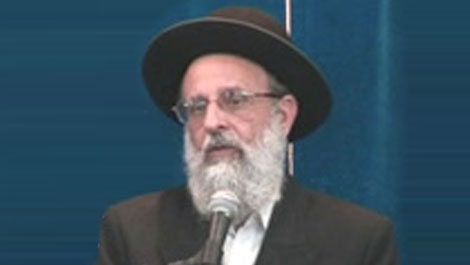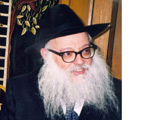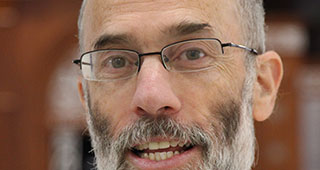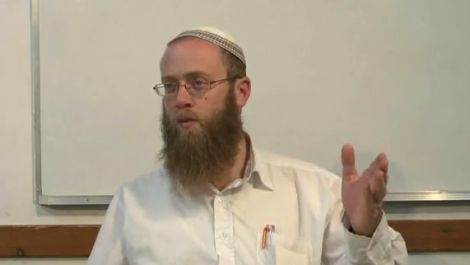Beit Midrash
- Family and Society
- The Jewish Household
- Kashrut
By Rabbi Yirmiyohu Kaganoff
Question #1:
Shem, the son of Noach, was traveling one day and realized that he had not packed enough peanut butter sandwiches for the trip. Now hungry, he witnessed a travel accident, the result of which was that an animal had been killed. Was he permitted to cook the carcass for lunch?
Question #2:
Shem’s descendant, Linda, lives in the modern era, and is Jewish. While traveling in an unfamiliar area, she hunts for kosher meat, discovering some with an unfamiliar supervision, and calls her rabbi to ask whether he recommends it. What factors does he consider in advising her whether to use this product?
Question #3:
In a previous position, I was responsible for researching sources of meat that our local Vaad HaKashrus would accept. I traveled to many cities, and visited many meat packing facilities. People have often asked why sometimes my hunt resulted in a new acceptable source, and why sometimes it did not. What was I looking for?
Before answering these questions, we need to understand what the Torah’s requirements for allowable meat are.
When Noach emerged from the teivah (the ark), Hashem told him that he and his descendants may now eat meat for the very first time. According to some authorities, prior to this time, no one was permitted to sink his teeth into a steak or even a schnitzel (Sanhedrin 59b, based on Bereishis 1:29-30, 9:3; as interpreted by Rambam, Hilchos Melachim 9:1 and Gur Aryeh, Bereishis 1:29). In actuality, not all authorities agree that Adam and his pre-mabul descendents were required to be vegetarian – some maintain that they were permitted to eat the meat of animals that had already died, and were forbidden only from killing animals for meat (Tosafos, Sanhedrin 56b s.v. achal; Rashi, Bereishis 1:29 and Sanhedrin 57a s.v. limishri basar, as understood by Mizrachi, Bereishis 1:29, cf. Gur Aryeh ad loc.). According to this opinion, pre-Noach mankind may have eaten a steak or schnitzel provided that they did not take the animal’s life.
Thus, whether Adam could barbecue road kill depends upon whether he held like Tosafos, in which case he could, or like the Rambam, in which case he could not. Otherwise, he was restricted to a vegetarian diet, which may have included the responsibility to check that his veggies were insect-free. Presumably, he called the local Vaad HaKashrus to determine how to check each type of vegetable. I wonder what he did when he wanted to eat Brussels sprouts, particularly since he probably lived before the invention of the light box!
However, when Noach emerged from the teivah, he and his descendents were permitted to give up their vegetarian lifestyle, provided that they ate no meat that had been removed from an animal while it was still alive (eiver min hachai). Just think, had Sheis lived after the time of Noach, he could have included some tuna sandwiches in his lunchbox, or picked up a few tins of sardines at the local grocery, instead of going hungry!
When the Torah was given, it both limited the species that a Jew may eat and created many other regulations, including the requirement that kosher meat and poultry be slaughtered in the halachically-approved way (shechitah) and that they may be eaten only if they are without certain defects that render them tereifah. Even after ascertaining that the animal itself may be eaten, one must still remove from sheep, goats, cattle and other "beheimos 1 " certain fats called cheilev, and one must remove the blood, and the sciatic nerve (the gid hanasheh) from all kosher animals, both beheimos and chayos. (The gid hanasheh of fowl is permitted.)
In the contemporary world, guaranteeing that one’s meat is appropriate for the Jewish table involves several trained and G-d-fearing people, including shochatim, bodekim, menakerim, mashgichim, and knowledgeable rabbonim to oversee the entire process.
THE SHOCHEIT’S JOB
Aside from the shocheit’s obvious responsibility to slaughter the animal the way Hashem commanded, he must also fulfill another very important task: following the slaughtering, he must verify that he performed the shechitah correctly. This is a very important step – without this inspection the animal or bird must be considered non-kosher – it will be acceptable for the table of Bnei Noach, but not for Klal Yisroel.
A common controversy in today’s modern packing facility is the use of a hydraulically-powered pen to restrain the animal while it is slaughtered. Although this pen usually makes the job safer and easier for the shocheit, there are concerns that the pen itself may render the animal a tereifah prior to its being slaughtered (Besheveilei Shechita). For this reason, no hechsher in Israel allows use of a pen during shechitah, but a different, equally safe and humane, system to restrain the animal is used instead.
Next, the animal or bird is examined to ensure that it is not tereifah. Although common use of the word "treif" means non-kosher for any reason whatsoever, the technical meaning of the word refers to an animal with a physical defect that renders it non-kosher even if it was the beneficiary of a proper shechitah.
THE BODEIK
In a meat packing plant (beef, veal or lamb), the individual accountable to check for these defects is called a bodeik (pl. bodekim). Most bodekim are trained shochatim, and, indeed, in many plants the bodekim and shochatim rotate their tasks, thus making it easier for them to be as attentive as the job requires. As a result, a person licensed both as a shocheit and as a bodeik is usually called a shocheit, although technically he should be called a shocheit ubodeik to truly reflect the extent of his training.
THE SECOND BODEIK
The responsibility to check for tereifos is divided between two bodekim. The first, the bodeik pnim, checks the lungs in situ, which is the only way one can properly check that the lungs do not adhere in an improper way to the ribs, the membrane surrounding the heart (the pericardium), or to themselves, all of which render the animal non-kosher. This checking is performed completely based on feel. The bodeik gently inserts his hand, and runs his fingers carefully over all eight lobes of the lung to see if he feels any adhesion between the lung and one of the other areas.
The second bodeik, the bodeik chutz, rechecks the lungs based on the report of the bodek pnim and makes a cursory check of other organs, particularly the stomachs and intestines, upon their removal from the carcass, for swallowed nails and for various imperfections that render the animal non-kosher.
After the two bodekim are satisfied that the animal is kosher, the second bodeik or a mashgiach tags or stamps the different parts of the animal as kosher. In many packing houses, the bodeik or a mashgiach makes small slits between the ribs that specifies the day and parsha of the week to identify that piece as kosher. A mark made when the meat is this fresh appears completely different from one made even a few hours later, making it difficult to counterfeit. Of course, this mark is not sufficient alone to verify that the meat is kosher, but it is an essential crosscheck, since tags can be tampered with.
The modern kosher poultry plant is organized slightly differently: The shochatim only perform shechitah, whereas the bedikah inspection is performed by mashgichim trained to notice abnormalities. If they notice any, they remove the bird from the production line; a rav or bodeik then rules whether these birds are kosher or not.
For both animals and birds, one needs only to check for commonly occurring tereifos and not for uncommon problems. For example, the established halachic practice is to check an animal’s lungs because of their relatively high rate of tereifos, and today it is common in Israel to check an area called the tzumas hagiddin on chicken thighs for specific kashrus problems. Animal lungs frequently have adhesions called sirchos which render them non-kosher (Chullin 46b), although Ashkenazic custom is that easily removed adhesions on mature animals do not render them treif (Rosh, Chullin 3:14; Rama, Yoreh Deah 39:13). An animal without any sircha adhesions is called glatt kosher, meaning that its lung is completely smooth – that is, without any adhesions, even of the easily removable variety. (I have written an article, What Makes Meat Kosher, which explains more about the complicated topic of glatt kosher, that is available on the website rabbikaganoff.com or that can be sent on request via e-mail.)
The rav hamachishir’s responsibilities include deciding which problems are prevalent enough to require scrutiny and what is considered an adequate method of inspection.
Depending on the factory, the next steps in the preparation of beef, veal or lamb are performed either in the same facility where the shechitah was performed, or at the butcher shop.
TRABERING
Prior to soaking and salting meat to remove the blood, certain non-kosher parts of the animal, including the gid hanasheh (the sciatic nerve), non-kosher fats called "cheilev," and certain large blood vessels must be removed (Yoreh Deah 65:1). The Hebrew word for this process is "nikur," excising, and the artisan who possesses the skill to properly perform it is called a menakeir (pl. menakerim). The Yiddish word for this process is traberen which derives from tarba, the Aramaic word for cheilev, the non-kosher fat. This step is omitted in the production of poultry, since it is exempt from the prohibitions of gid hanasheh and cheilev, and its blood vessels are small enough that it is sufficient to puncture them prior to the soaking and salting procedures.
Early in its butchering, a side of beef (which is half its carcass) is divided into its forequarter and hindquarter. Since the gid hanasheh and most of the cheilev are located in the hindquarter, trabering it is a tedious process that requires a highly skilled menakeir. (I have written an article on the history and halachic issues germane to this practice, which is not yet posted on the website, but is available from me directly. This article will iy’H be posted in the near future.) The forequarters must still be trabered prior to soaking and salting to remove blood vessels and some fat (Rama, Yoreh Deah 64:1; Pischei Teshuvah 64:3). Although a relatively easy skill to learn, Linda’s rabbi might need to check whether one can trust this hechsher as to the proper performance of this procedure, as the following story indicates:
I once investigated the kashrus of a certain well-known resort hotel, one not usually frequented by frum clientele. I called the hotel and asked who provided their hechsher, and was soon on the telephone with both the resident mashgiach and the rav hamachshir.
I began by introducing myself and the reason for my phone call, and then asked about the sources of the meat used in the hotel. In the course of the conversation, it became evident that neither the rabbi nor the mashgiach knew the slightest thing about traberen, although they were officially overseeing a staff of in-house butchers, none of whom was an observant Jew. I realized that the rather poor kashrus reputation of this establishment was indeed well deserved. The rabbi overseeing the hechsher himself did not know trabering, nor did he have anyone else halachically reliable supervising. What was he overseeing?
Indeed, I have discovered many facilities that do not traber meat properly or even places that do not bother to traber their meat at all. Thus, we have another reason why some products may not be approved for use.
SOAKING AND SALTING
Returning to our brief overview of the proper preparations for kosher meat -- after the meat has been properly trabered, it is ready to be soaked and salted to remove its blood. In earlier generations, this process, usually called kashering meat, was performed exclusively at home, but today common practice is that this is performed by the butcher or at the abattoir. Almost all kosher poultry operations today soak and salt the meat immediately after shechitah, and this approach is now becoming increasingly more common in beef operations.
To kasher meat it should be rinsed well, soaked in water for half an hour, drained properly, salted for an hour, and then rinsed three times (Rama, Yoreh Deah 69:1, 5, 7). The halacha requires that the meat be covered with salt on all exposed surfaces (Yoreh Deah 69:4). Most packing plants that I have seen perform this part of the job effectively, although I have seen places where the salting was inadequate -- entire areas of the meat were not salted. This is probably simple negligence; although when I called this problem to the attention of the mashgiach he insisted that it had been performed adequately, notwithstanding my observing the contrary. Needless to say, I did not approve this source.
Sometimes, there is also concern about the koshering of poultry. Poultry must also be salted with its meat covered with salt on all its exposed surfaces. There is a dispute among authorities whether a bird’s abdominal cavity must be opened fully to guarantee that it is salted properly (Beis Lechem Yehudah 69:20; Pri Megadim, Mishbetzos Zahav 69:15). Many contend that in modern facilities one should not rely that the employees, many of whom are not Jewish or are not observant of the laws of kashrus, will make sure to salt all exposed areas inside the bird’s cavity. To avoid this problem, one can either have observant staff be responsible to salt the meat, or alternatively, to have a mashgiach check that everything is done properly.
WASHED MEAT
The Geonim instituted a requirement that meat be soaked and salted within 72 hours of its slaughter (Yoreh Deah 69:12). This is because of concern that once 72 hours have passed the blood becomes hardened inside the meat and salting no longer removes it. If more than 72 hours passed without the meat being salted, the Geonim ruled that the meat may be eaten only if it is broiled since this process will still remove the blood (Yoreh Deah 69:12).
A question that developed with time was whether wetting the meat prevents the blood from hardening inside. Some early authorities permitted soaking meat to extend the 72 hour period (Shach 69:53). However, this leniency often led to highly liberal interpretations. I have seen butchers take a damp rag and wipe the outside of the meat and considered it washed. Thus, there are two different reasons why most reliable kashrus operations do not allow the use of "washed meat," either because they do not accept this leniency altogether, or because of concern that once one accepts hosed meat, it becomes difficult to control what type of washing is acceptable.
THE RAV HAMACHSHIR
Thus far, I have described the tremendous responsibilities of most of the staff necessary to guarantee that the meat is of the highest kashrus standards. One person that I have not adequately discussed is the rav hamachshir, the supervising rabbi, who has the final say on the kashrus standards that the meat packer and butcher follow. Although a rav overseeing meat kashrus does not necessarily have to be a shocheit or a trained menakeir himself, he certainly must be expert in all of these areas, both in terms of thorough knowledge of halacha and in terms of practical experience. For most of Jewish history, the most basic requirement of every rav required him to be proficient in all the halachos of kosher meat production. As the local rav, all shechitah and bedikah in his town was his responsibility.
However, in the contemporary world of mass production and shipping, the local shul rav is rarely involved in the details of shechitah, and often has limited experience and training in these areas. Depending on the semicha program he attended, he may not have been required to study the laws of shechitah and tereifos. Thus, what was once the province of every rav has now become a specialty area, and sometimes rabbonim involved in the giving of meat hechsherim lack the proper training.
I was once given a tour of a meat packing plant by the supervising rabbi of the plant. During the course of the tour I became painfully aware of the rabbi’s incompetence in this area of kashrus. For example, he was clearly unaware of how to check shechitah knives properly, certainly a basic skill necessary to oversee this type of hechsher. Would you approve this meat supplier for your local Vaad HaKashrus?
At this point, I want to address the third question I raised above: Sometimes my visit to a meat packer resulted in a new acceptable source, and sometimes it did not. What was I looking for, and why would I disapprove a source that a different rav was approving?
The answers to these questions are sometimes subjective, but I will provide you with some observations of mine.
IS THE SYSTEM WORKABLE?
There are many subtle and not-so-subtle observations that a rav makes when examining a meat packer. I could not possibly list in one article all the types of problems I have seen, but I will mention certain specific concerns for which I would always be attentive.
Is the production line too quick for the shocheit or mashgiach to do his job properly? Are the shochatim or mashgichim expected to perform their job in an unrealistic manner, either because of a shortage of trained manpower or because of the speed or arrangement of the production line?
QUALITY OF PERSONNEL
Are the shochatim knowledgeable? Do they appear to be G-d fearing individuals? Although it is impossible to know whether someone is indeed a yarei shamayim, it is unfortunately often very obvious that he is not. It can indeed happen that one rav has questions about the staff – for this reason, he does not approve a source of supply.
I will give you an example that will better elucidate this problem. While visiting a plant to determine whether we should allow this shechitah, the conversation of one of the shochatim showed a shortcoming in tzniyus within his family. Although one cannot point to a specific law that disqualifies him as a shocheit, I personally was uncomfortable entrusting him with decisions that would affect what I eat. After discussion with the other rabbonim in our community, we decided not to accept meat from this shechitah.
Does this mean that we considered this meat non-kosher? G-d forbid. It simply means that we were uncomfortable allowing it and decided that we have that responsibility as rabbonim of our community.
Thus, it could indeed happen that what one rav considers acceptable another rav feels is not. The differences may be based on the interpretation of halacha, or they may result from a rav’s opinion as to how a plant should be run.
CONCLUSION
Based on the above information we can better understand many aspects of the preparation of kosher meat and why it is important to use only meat that has a proper hechsher. We can also gain a greater appreciation of how hard rabbonim and shochatim work to maintain a high kashrus standard. Now that we recognize the complexity involved in maintaining kosher meat standards, we should always hope and pray that the food we eat meets all the halachic requirements that the Torah commands us.
^ 1.Kosher land animals are divided into two categories, beheimah and chayah. Although beheimah (pl., beheimos) is often translated as domesticated species and chayah (pl., chayos) as wild species, these definitions are halachically inaccurate since whether a species is categorized as a beheimah or as a chayah has no bearing on whether it is domesticated or not. Reindeer, although domesticated, are clearly a chayah since they have branched antlers, whereas there are non-domesticated species, such as bison, that are almost certainly beheimah according to halacha.
The Written Torah did not indicate the defining characteristics distinguishing beheimos from chayos, leaving these rules to the Torah sheba’al peh, the Oral Torah. The Gemara (Chullin 59b) mentions several characteristics, mostly dependent on the animal's horns: A branched horn defines its species as chayah, whereas non-branched horns may indicate either a chayah or a beheimah depending on whether they grow in layers, are grooved, and whether their tips are curved or straight (Rashi ad loc.; cf. Rabbeinu Chananel). Therefore, any species possessing branched horns or antlers like those found on most deer is a chayah, whereas those with straight horns may be either chayah or beheimah depending on the other criteria. Since all antelope (a general category that includes several dozen species) have un-branched horns, one would need to examine the horns of each species to determine whether it is a beheimah or a chayah. (Technically speaking, the difference between deer and antelope is that deer have antlers that shed and re-grow annually, whereas antelope have permanent un-branched horns.)
This Shiur is published also at Rabbi Kaganof's site

























